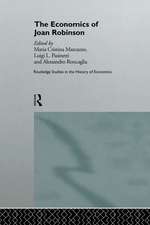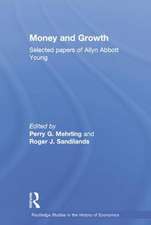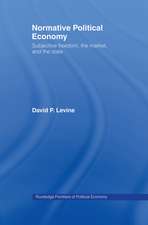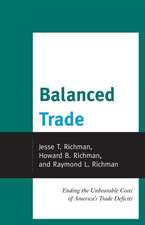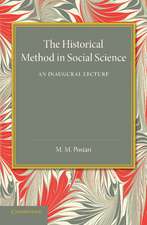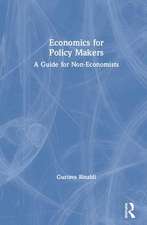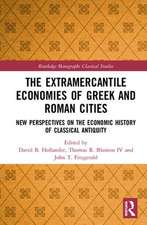The Economic Ideas of Marx's Capital: Steps towards post-Keynesian economics: Routledge Frontiers of Political Economy
Autor Ludo Cuyversen Limba Engleză Hardback – 15 sep 2016
Starting with Marx’s schemes of reproduction, which, it is shown, are the basis of the linear model of production as used since the 1960s by Piero Sraffa, Michio Morishima and others, the book reviews and assesses Marx’s major economic theses. These include: the labour theory of value; accumulation and technical change and its impact on labour; the concept of unproductive labour; the tendential falling rate of profits; the evolution and determinants of the share of wages in national income; as well as short-run and long-run economic dynamics. The Economic Ideas of Marx's Capital updates the theses of the labour theory of value and the conditions for balanced growth using the recent scholarly literature, and also further develops issues related to Marx’s concept of productive labour. Moreover, the book analyses the intellectual relationship of Marx’s economic theory with post-Keynesian neo-Marxism, particularly in the writings of Michal Kalecki, Joan Robinson and others. By doing so, the book shows the need and possibilities of integrating major insights of Marxist and post-Keynesian theory.
This volume will be of interest to those who wish to explore Marx’s economic theories through a non-ideological approach, as well as students of Marxist economics, post-Keynesian economics and the history of economic thought.
| Toate formatele și edițiile | Preț | Express |
|---|---|---|
| Paperback (1) | 303.01 lei 6-8 săpt. | |
| Taylor & Francis – 25 iul 2018 | 303.01 lei 6-8 săpt. | |
| Hardback (1) | 767.07 lei 6-8 săpt. | |
| Taylor & Francis – 15 sep 2016 | 767.07 lei 6-8 săpt. |
Din seria Routledge Frontiers of Political Economy
-
 Preț: 309.90 lei
Preț: 309.90 lei -
 Preț: 309.79 lei
Preț: 309.79 lei -
 Preț: 316.03 lei
Preț: 316.03 lei -
 Preț: 152.66 lei
Preț: 152.66 lei - 9%
 Preț: 867.54 lei
Preț: 867.54 lei -
 Preț: 151.96 lei
Preț: 151.96 lei -
 Preț: 311.61 lei
Preț: 311.61 lei -
 Preț: 286.98 lei
Preț: 286.98 lei -
 Preț: 327.83 lei
Preț: 327.83 lei - 9%
 Preț: 1005.48 lei
Preț: 1005.48 lei -
 Preț: 325.09 lei
Preț: 325.09 lei - 9%
 Preț: 938.47 lei
Preț: 938.47 lei -
 Preț: 386.11 lei
Preț: 386.11 lei -
 Preț: 324.87 lei
Preț: 324.87 lei -
 Preț: 310.95 lei
Preț: 310.95 lei -
 Preț: 318.54 lei
Preț: 318.54 lei -
 Preț: 317.95 lei
Preț: 317.95 lei -
 Preț: 310.01 lei
Preț: 310.01 lei -
 Preț: 326.49 lei
Preț: 326.49 lei -
 Preț: 155.43 lei
Preț: 155.43 lei -
 Preț: 309.79 lei
Preț: 309.79 lei -
 Preț: 328.76 lei
Preț: 328.76 lei -
 Preț: 281.72 lei
Preț: 281.72 lei -
 Preț: 286.58 lei
Preț: 286.58 lei -
 Preț: 371.95 lei
Preț: 371.95 lei -
 Preț: 353.77 lei
Preț: 353.77 lei -
 Preț: 310.55 lei
Preț: 310.55 lei -
 Preț: 302.75 lei
Preț: 302.75 lei -
 Preț: 312.86 lei
Preț: 312.86 lei -
 Preț: 374.16 lei
Preț: 374.16 lei -
 Preț: 329.09 lei
Preț: 329.09 lei -
 Preț: 348.21 lei
Preț: 348.21 lei - 28%
 Preț: 1047.06 lei
Preț: 1047.06 lei - 18%
 Preț: 1169.45 lei
Preț: 1169.45 lei - 18%
 Preț: 1555.17 lei
Preț: 1555.17 lei - 18%
 Preț: 1048.43 lei
Preț: 1048.43 lei - 18%
 Preț: 1059.84 lei
Preț: 1059.84 lei - 31%
 Preț: 767.47 lei
Preț: 767.47 lei - 18%
 Preț: 731.92 lei
Preț: 731.92 lei - 26%
 Preț: 822.54 lei
Preț: 822.54 lei - 18%
 Preț: 1796.21 lei
Preț: 1796.21 lei - 26%
 Preț: 1184.91 lei
Preț: 1184.91 lei - 18%
 Preț: 1120.23 lei
Preț: 1120.23 lei - 15%
 Preț: 700.95 lei
Preț: 700.95 lei - 18%
 Preț: 1116.31 lei
Preț: 1116.31 lei - 22%
 Preț: 299.52 lei
Preț: 299.52 lei - 18%
 Preț: 999.46 lei
Preț: 999.46 lei - 18%
 Preț: 1169.78 lei
Preț: 1169.78 lei
Preț: 767.07 lei
Preț vechi: 1104.44 lei
-31% Nou
Puncte Express: 1151
Preț estimativ în valută:
146.77€ • 153.66$ • 121.45£
146.77€ • 153.66$ • 121.45£
Carte tipărită la comandă
Livrare economică 05-19 aprilie
Preluare comenzi: 021 569.72.76
Specificații
ISBN-13: 9781138938977
ISBN-10: 1138938971
Pagini: 336
Ilustrații: 52
Dimensiuni: 156 x 234 x 24 mm
Greutate: 0.61 kg
Ediția:1
Editura: Taylor & Francis
Colecția Routledge
Seria Routledge Frontiers of Political Economy
Locul publicării:Oxford, United Kingdom
ISBN-10: 1138938971
Pagini: 336
Ilustrații: 52
Dimensiuni: 156 x 234 x 24 mm
Greutate: 0.61 kg
Ediția:1
Editura: Taylor & Francis
Colecția Routledge
Seria Routledge Frontiers of Political Economy
Locul publicării:Oxford, United Kingdom
Public țintă
Postgraduate and UndergraduateCuprins
Contents
Preface
Introduction
Chapter 1: Economic reproduction
Chapter 6: Long-term developments - the tendency of the rate of profits to fall
Preface
Introduction
Chapter 1: Economic reproduction
- Production and reproduction
- The Marxist schemes of reproduction : introduction
- The workings of the Marxist schemes of reproduction under capitalism
- What can be learned from Piero Sraffa’s "standard system"?
- The significance of the Marxist schemes of reproduction
- What is the labour theory of value saying?
- The transformation problem
- Marxian prices of production
- Production prices proper
- The mathematical formulation of values and prices
- Elements of a formal solution to the transformation problem: corrections of Marx’s procedure
- Prices of production as the sum of dated labour time
- Marx’s "average sector" and Sraffa’s "standard system"
- Prices of production as the outcome of iterative adjustments, starting from labour values
- What is the logic in transforming values into prices of production?
- The rate of surplus value determines the rate of profits, not the other way round (Morishima’s "Fundamental Marxian Theorem")
- The transformation of labour values into prices of production: logic or reality?
- A short digression into technological coefficients, subsistence wages and the "law of value"
- What about monopoly prices?
- Post-Keynesian views about the labour theory of value
- To conclude
- The "standard system" again
- The maximum rate of growth and the attainable economic growth in case of non-necessary consumption
- Full versus incomplete realisation of surplus value
- What about social necessary consumption?
- The contribution of the post-Keynesian neo-Marxists
- Spending out of surplus value
- Cost-increasing inputs, value creation and the technological inputs structure
- The translation of unproductive inputs and outputs in the linear model of production
- Prices and cost-increasing inputs in the total inputs structure
- Unproductive cost-increasing inputs and the rate of profits
- Unproductive labour today and further arguments
- Capitalist cost-increasing inputs: productive but wasteful …
- Conclusions
- Marx on the relationship between capital accumulation, the rate of profits and the wage rate, and the so-called "industrial reserve army"
- The capitalist hunger for super-profits as the motivation for technical change and innovation
- The effect of technical change on the surplus value and the rate of surplus value
- The effect of technical change on the organic composition of capital
- An increase in labour productivity with unchanged proportional inputs of means of production
- An increase in labour productivity with decreasing proportional inputs of the means of production
- An increase in labour productivity with increasing proportional inputs of the means of production
- The scope for labour-saving but also capital-using technical change in the pursuit of super-profits
- How did the early post-Keynesians look at mechanisation and technical change? The case of Joan Robinson’s "real-capital ratio"
- To conclude
Chapter 6: Long-term developments - the tendency of the rate of profits to fall
- Marx’s theory of the falling rate of profits - in a nutshell
- The rate of profits in the linear production model
- The relationship between labour-saving technological change and the rate of profits: generalisations in Okishio’s theorem
- The rate of profits in the long run: some statistical data
- Absolute and relative surplus value from Marx’s standpoint
- Class struggle and the share of labour in value added
- Exploitation and class struggle: game-theoretical insights
- The degree of monopoly and "mark-up" pricing
- The working of the "profits squeeze": some neo-Keynesian and neo-Marxist interpretations
- Some statistical evidence
- What to conclude?
- The economic cycle in Das Kapital
- The economic cycle and the post-Keynesian neo-Marxists
- Labour values and prices of production in money terms
- Money and credit in Das Kapital
- The money supply in post-Keynesian economic theory.
- Economic crisis and the role of money capital
- Notebook B 113
- To conclude
- Underspending and incomplete realisation of surplus value in Das Kapital
- Underspending based on the schemes of reproduction
- The importance of external markets for surplus value realisation in the long run
- The importance of military spending for surplus value realisation in the long run
- Technological innovations as an "external market"
- Long waves in economic activity and accumulation?
- The development of the service sector and "financialisation" of the capitalist economy
- To conclude
- The importance of the "no nonsense" approach of Das Kapital
- The linear Marx-Leontief production model
- Which of the fundamental principles of Marx’s economic theory are still intact: value, unproductive labour and the "law of value"?
- What about the dynamics in Marx’s economic theory: technological innovation, the rate of profits and exploitation in the long run, economic cycles …?
- Is Marx’s economics an independent doctrine, a module of the post-Keynesian theory or a starting point for a post-Keynesian neo-Marxist synthesis?
Notă biografică
Ludo Cuyvers is Emeritus Professor at the University of Antwerp, Belgium and Extraordinary Professor at North-West University, South Africa.
Descriere
Starting with Marx’s schemes of reproduction, this book reviews and assesses Marx’s major economic theses. These include: the labour theory of value; accumulation and technical change and its impact on labour; the concept of unproductive labour; the tendential falling rate of profits; the evolution and determinants of the share of wages in national income; as well as short-run and long-run economic dynamics. The Economic Ideas of Marx's Capital updates the theses of the labour theory of value and the conditions for balanced growth using the recent scholarly literature, and also further develops issues related to Marx’s concept of productive labour.




